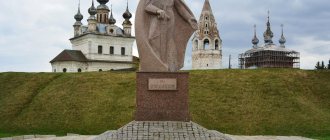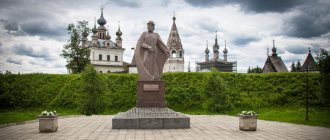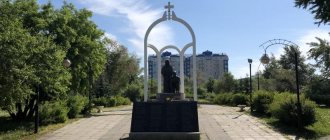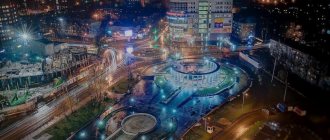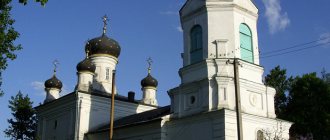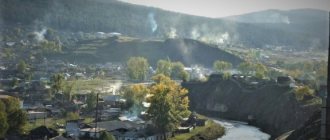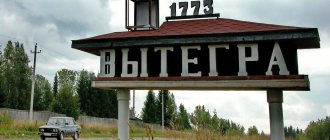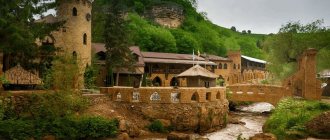What to see in Yuryev-Polsky in 1 day – TOP 3 places
Yuryev-Polsky is full of interesting sights, but among them there are three special places that are worth visiting for any tourist, even those who come here for one day.
Historical, Architectural and Art Museum (Yuryev Kremlin)
- Address: st. May 1, 4.
The richest collection of museum exhibits is located in the ancient buildings of the Archangel Michael Monastery. 16 thousand works of art and antiquities are distributed across several exhibitions. Here you can see personal belongings of aristocrats brought from their estates, exquisite porcelain items, and unique wooden sculptures.
One of the main exhibitions of the museum is dedicated to the Patriotic War of 1812. The collection consists of various evidence of the struggle of the Russian people against French troops.
Another room houses a small art gallery consisting of paintings from the 16th and 17th centuries. In the Archimandrite building you can see the works of Vladimir weavers. Guests of the city are also recommended to visit the local history exhibition, which will help to better understand the life of Yuryev residents of past years.
Honeymooners Park
- Address: 1st May Street.
Beautiful park of St. Peter and Fevronia Muromsky quickly gained popularity among both local residents and tourists. In a short period of time, several traditions have developed in the park. Lovers often meet on the Kissing Bridge, and wedding photo sessions on the Brides' Glade have become an integral part of many weddings.
Local newlyweds also like to pose near a sculptural composition in the form of crossed wedding rings with the inscription: “Advice and love.” From time to time, on the territory of the attraction you can see an unusual flower tent in the shape of a fairy-tale carriage.
St. George's Cathedral
- Address: Museum Lane.
The white-walled temple complex with a huge black dome is reminiscent of the famous Church of the Intercession on the Nerl. The cathedral has survived several eras and undergone many changes. One of the oldest churches in Russia was built in 1234 by order of Prince Svyatoslav Vsevolodovich and still remains one of the best examples of Vladimir-Suzdal architecture.
Previously, on the site of the magnificent stone cathedral there was a small church, which was founded by Yuri Dolgoruky. In each new city, the prince erected a temple in honor of his heavenly patron. Yuryev-Polsky was no exception. When the old building was damaged by an earthquake, the grandson of the great ruler Svyatoslav erected a new building, which amazed with its luxurious stone carvings.
In the mid-15th century, craftsmen from Moscow strengthened the dilapidated walls of the church and damaged the carved paintings, but managed to preserve a unique architectural monument. Cathedral of the Great Martyr. St. George the Victorious preserves ancient paintings, valuables and shrines, the main one of which is the Svyatoslav Cross. The prince made a large crucifix out of stone in gratitude to God for salvation in one of his military campaigns.
Monument to Yuri Dolgoruky
Address: Yuryev-Polsky, Vladimirskaya street
In 2002, on the 850th anniversary of Yuriev-Polsky, in the central part of the city, on the square near the defensive ramparts, a monument to Yuri Dolgoruky was erected. The author of the work was the sculptor Igor Chernoglazov.
The monument to the Yuryev-Polsky landmark is made of dark granite. The figure of the prince carved from stone stands at full height, and his gaze is directed into the distance. Around the pedestal with Yuri Dolgoruky sit his defenders - lions. They are located on both sides of the architectural complex.
Interesting places in the vicinity of Yuryev-Polsky
In the vicinity of the city of Yuryev-Polsky, tourists will find many picturesque places, remarkable for their history and natural landscape.
Earthen ramparts (Mstislavl settlement)
- Address: s. Settlement.
The grassy earthen ramparts of Mstislavl are the main mystery of the area, hills that attract treasure hunters and lovers of mysticism. Over the course of several centuries, the once flourishing city was completely destroyed and wiped off the face of the earth. Having fallen victim to the Tatar-Mongol yoke, Mstislavl lost its former greatness and finally disappeared during the years of Soviet power. Now only hills, a deep ditch and the ruins of the Church of the Nativity remind us of the ancient city. The church was destroyed during the Soviet Union and now only the dilapidated four-tiered bell tower rises alone over the meadows.
Golitsyn Estate
- Address: s. Sima.
The estate in the village of Sima, Yuryev-Polsky district, became famous thanks to several famous families. The small village is a gift to General Mikhail Golitsyn from Peter the Great, a reward for military merits. Having received the land into possession, Mikhail Mikhailovich ordered to build a house with outbuildings on it, plant a park and dig a pond.
The history of the estate is also closely connected with the fate of the great commander Peter Bagration, a relative of the Golitsyns. After being seriously wounded in the fields of Borodino, the general came to Sima, where he spent his last days before his death. The commander's body was buried near the village church of St. Demetrius of Thessalonica, but was later reburied.
After the Revolution, the noble estate became a shelter for orphans. Currently, the manor house houses a library and a museum named after. P. Bagration and the local House of Culture.
Apraksin Estate
- Address: s. Ratislovo.
The once rich 18th century manor has only partially survived. Before the Revolution, there was a tall manor house, two outbuildings for servants and the Kazan Church. A large park was laid out for the Apraksin nobles, containing eight fairly large ponds. Of all the buildings, today you can only see the main house, which has lost its former beauty. The double building housed the school. Tourists can stroll through the wonderful park and admire the ponds.
Shopping arcades and Gostiny Dvor
On the northern side, the ancient earthen ramparts of Yuryev-Pokrovsky have been adjacent to the trading area for many centuries, which is now called “Sovetskaya”. On it there are stone buildings of the Trading Rows and the two-story Gostiny Dvor, built back in 1873-1877. They appeared instead of the burnt wooden buildings of Gostiny Dvor. The difference between the Yuryev-Polsky Trading Rows and the rows in Suzdal, Vladimir and Kostroma is the absence of a courtyard.
In the 19th century, the customers of Gostiny Dvor were local traders: merchants and manufacturers. Here they organized premises for trading and storing their goods. In the last century, the buildings housed shops, pubs, inns and warehouses. Now most of the shops are empty, and many of the awnings are rickety.
Yuriev-Polsky monasteries and monasteries
On the territory of Yuryev-Polsky and its environs there are several monasteries, whose fate is closely intertwined with the history of Russia.
St. Vvedensky Nikon Monastery
- Address: Kalanchevsky Lane.
Historians cannot say exactly when the Holy Vvedensky Monastery was built. The first written mentions of the convent date back to the first half of the 17th century. It is believed that the Nikon Church was built on the site of the house where St. Nikon of Radonezh, the spiritual son and disciple of St. Sergius of Radonezh, was born.
At the beginning of the 18th century, a fire destroyed two monastery churches, leaving only St. Nicholas Church. Half a century later, on the site of the burnt wooden buildings, the stone Vvedensky Cathedral with stucco “kokoshniks” above the windows and neat carvings arose. A little later, the temple was complemented by a four-tier high bell tower - the tallest building in the city.
The fire of 1871 disrupted the quiet life of the monastery. All buildings were in disrepair, which is why the continued existence of the monastery was in jeopardy. The nuns and novices were moved to the parish of the Church of Peter and Paul, where over time the Peter and Paul Monastery was formed.
Under the Bolsheviks, the Holy Vvedensky Monastery was finally abolished, the beautiful bell tower was destroyed, and the spacious church premises were used as warehouses. Today the monastery is being restored after numerous upheavals of the 20th century, already in the status of a male monastery complex.
Michael the Archangel Monastery
- Address: Yuryevsky Kremlin.
One of the oldest communities in Russia and a real architectural reserve, the Archangel Michael Monastery is both an active monastery and the main museum of the area.
The monastery grew up on the ramparts of the more ancient Yuryev-Polsky Kremlin. It is believed that the monastery was founded by Prince Svyatoslav Vsevolodovich. The first monastery buildings from the 13th century have not survived; the earliest buildings date back to the mid-17th century. The most valuable buildings from the point of view of history are the Znamenskaya refectory church, the tented bell tower and the gate church of St. ap. John the Theologian. The main cathedral of the Archangel Michael, as well as the archimandrite and fraternal buildings were built in the 18th century.
The history of the monastery is very tragic. Due to its geographical location, Yuryev-Polsky repeatedly found himself in the path of invaders marching on Moscow and was attacked by enemies. Along with the entire city, foreigners also destroyed the Archangel Michael Monastery. The long-suffering monastery literally rose from the ashes four times. Over the years, the khans Batu, Tokhtamysh and Edigei sought to destroy Orthodox churches, burned buildings, and killed the monastic brethren. In the 17th century, similar misfortunes were brought about by Polish invaders.
The last serious test for the monastery was anti-church persecution during the Soviet period. The monastic community was banned, and the buildings housed museum exhibitions that are still open to this day. Currently, monastic life is being resumed on the territory of the museum, and services are again held in the Church of St. Michael the Archangel.
Monastery of St. ap. Peter and Paul
- Address: Krasny Poselok quarter.
According to some sources, the Peter and Paul Convent was founded back in the 16th century, but all known stone buildings date back to the 19th century. The center of the monastery was the Cathedral of Peter and Paul, and the Church of the Assumption of the Blessed Virgin Mary stood nearby. Several decades later, the temples fell to the communists; only the luxurious five-tiered bell tower survived. The monastic lands were transferred to the Krasnoselsky state farm. In 2010, the revival of the monastery began. Only the walls of the old churches remain, so services are held in the former cemetery Church of the Ascension of the Lord.
St. Nicholas Monastery
- Address: Novoe village, 11.
The convent is located not far from Yuryev-Polsky - in the village of Novoe. Stone Church of St. Nicholas of Myra grew up in 1826 on the site of an old wooden building. Initially it was a simple parish church. In Soviet times, the Church of St. St. Nicholas the Wonderworker was one of two regional churches that escaped closure and destruction.
Knowing this, believers brought church valuables here. The church became the custodian of the five great shrines of the region - the miraculous icons of the Blessed Virgin Mary. In the 70s, a small community of several secret nuns formed in the parish. In 1995, the community received a bishop's blessing and began to officially be called a convent.
Peter and Paul Monastery
The exact time of the founding of the Peter and Paul Convent is unknown; it appeared in the northern part of the city around the 16th-17th centuries. In the 19th century, a stone Peter and Paul Cathedral was built on the territory of the monastery, and a little later the Assumption Church, with a high five-tier bell tower, was erected nearby.
After 1917, the Peter and Paul Monastery was closed and the buildings were destroyed. Of all the former grandeur, only the five-tiered bell tower has survived. Today, the women's monastery is being revived.
Temples and churches of the city
Yuryev-Polsky, like every ancient Russian city, is rich in churches. Many priceless examples of ancient architecture have survived to this day.
Church of the Nativity
- Address: per. Avant-garde.
The Church of the Nativity forms a single complex together with the Boris and Gleb Church. Services in the spacious five-domed Church of the Nativity of Christ took place in the summer, while the younger Church of Boris and Gleb was used during cold weather. The latter was significantly smaller in size, making it easier to heat. The low temple with small windows retained heat even in severe frosts.
During the Soviet years, both churches were looted and converted into dairy factory workshops, which greatly damaged the ancient buildings. The bell tower was dismantled to its foundations. After the collapse of the Union, restoration work began, which continues successfully to this day.
Church of the Life-Giving Trinity
- Address: st. May 1st.
One of the youngest temples in the city surpasses many ancient religious buildings in its scale and splendor. The luxurious red-brick cathedral with lush decoration in neo-Russian style marked the three-century anniversary of the Romanov dynasty. The temple did not last long; two years after the opening, the Revolution took place. The Soviet government did not spare the architectural masterpiece: the cathedral was beheaded and closed, church values disappeared without a trace. Several years ago the church was transferred to the Archangel Michael Monastery. At the moment, the cathedral is undergoing restoration.
Church of St. Nikita Martyr
- Address: st. Pokrovskaya.
The small, but very beautiful and cozy Nikitskaya Church was built at the end of the 18th century. The classic building attracts attention from afar thanks to the bright combination of white, red, green and blue colors. The outside of the building is decorated with antique porticoes with columns. The drum is dotted with numerous windows, thanks to which the inside of the temple is well lit even in cloudy weather.
The Temple of Nikita the Martyr was able to survive when the Bolsheviks came to power, but was closed at the beginning of the Great Patriotic War. A car repair shop opened on the premises. Where once there had been chants and the scent of incense, there was now the sound of metal clinking and the smell of exhaust fumes. In the year of the 1000th anniversary of the Baptism of Rus', the building was returned to the Church and completely restored. Today the church is open to believers.
St. George's Church (wooden)
- Address: Yuryevsky Kremlin.
A small log church of an unusual shape was built in the village of Yegorye (Egoriy) at the beginning of the 18th century. Talented architects created a temple without nails, using only axes. According to some sources, the church belonged to the St. George Monastery of the mid-16th century, which ceased to exist several centuries ago. In the mid-20th century, the building was transported to the Archangel Michael Monastery. A few meters from the church there is a small Nadkladeznaya chapel. A wooden chapel covers a well filled with water from a holy spring.
Intercession Church
- Address: st. Embankment.
The modern stone Church of the Intercession of the Blessed Virgin Mary stands on the site of a burnt wooden church built in 1712. According to the plan of its founder, monk Kirill, the temple was to become the center of the Intercession Convent, but the monastic community lasted only a few years. The nuns moved to the Holy Vvedensky Monastery, and the church became a simple lay parish.
After some time, a fire incinerated the wooden building. The new stone structure was erected in one year with donations from local residents. Already in 1769, the church opened its doors to parishioners.
In the 19th century, the temple was decorated with a magnificent three-tier bell tower with stained glass windows. After the Revolution, the architectural monument was turned into a workshop. In the 90s the temple was returned to the Church. Nowadays, many pilgrims from all over the country come to the Intercession Church to venerate the relics of the holy noble prince Svyatoslav Vsevolodovich, found shortly before the revival of the church.
Trinity Church in the village. Podolets
- Address: Podolets village.
The unique two-tier temple was erected in 1659 on the estate of the princes Miloslavsky. Inside there were four chapels: the Life-Giving Trinity, St. Joachim and Anna, ap. Andrew the First-Called and St. Mary of Egypt. Several members of the noble family are buried in the lower temple. The USSR did not appreciate the splendor of the church, and for many decades the ancient building was destroyed under the influence of natural elements. Today, thanks to the work of restorers, the temple has received a chance for a new life and is slowly being restored.
Church of the Intercession of the Blessed Virgin Mary
Address: Yuryev-Polsky, Naberezhnaya street.
The Church of the Intercession was built in 1712 through the efforts of monk Kirill from the St. Michael the Archangel Monastery. Not far from the Church of the Intercession, the monk also erected a small number of wooden cells. But the monastery did not exist for long; soon the temple was turned into a parish church. In 1768, due to the fault of the servants, it completely burned down, although local residents managed to save the icons and utensils from the building. In just a year, the townspeople raised funds and built a new Church of the Intercession, which stands in Yuryev-Polsky to this day.
Architecture and beautiful buildings
Yuryev-Polsky is a place of contrasts. Typical five-story buildings alternate with ancient buildings, thanks to which you can trace the development of urban architecture from ancient times to the present day.
Shopping arcades
- Address: pl. Soviet.
Trading premises, traditional for many Russian cities, appeared in Yuryev-Polsky in the 18th century. A hundred years later, a strong fire destroyed the wooden buildings, and soon a new building arose in their place, which has survived to this day. The Yuriev-Polsky ranks made a small contribution to domestic cinema: in the 60s of the last century, the film “The Golden Calf” with S. Yursky in the title role was filmed here. While walking along the Trade Rows, tourists can do two pleasant and useful things at once - examine the architectural monument and buy the necessary goods in the shops located in it.
Barn
- Address: per. Avangardsky, 3.
The unremarkable red building made of simple brick is an architectural monument of the 19th century. For a long time, merchant goods were stored here, but during the years of “dekulakization” the building was recognized as socialist property and turned into a city warehouse.
Fire station
- Address: Vladimirskaya st., 12.
The interesting brick building in the Gothic style has been well preserved despite its hundred years of age. The depot has been used for its intended purpose at all times, under any government. In some rooms dance evenings and theatrical performances were held, in others fire engines were waiting to be called. The gray building with its unusual shape stands out among other city buildings.
Almshouse of the Meshcherins
- Address: st. May 1st, 16.
The remarkable two-story red brick building was erected at the beginning of the 20th century with the money of local philanthropist G.I. Meshcherina. The almshouse accommodated more than 150 people of both sexes, mainly townspeople and old merchants. Currently, the former almshouse continues to benefit people: the central hospital of the region operates in the building.
Shevelkin Inn
- Address: 1st May Street, 33.
Good, memorable photos are also taken against the backdrop of this architectural landmark of Yuryev-Polsky. The building of the Shevelkins' inn was built approximately at the end of the 19th century, in the form of a two-story building with a blue and white facade and beautiful, bordered windows. The entrance is crowned by a pretty porch.
Khlebnikov's shop
- Address: st. 1st May, 4.
In the central part of the city, almost every building is an object of cultural heritage of municipal or federal significance. So is the former Khlebnikov Shop, built in the 19th century and a decoration of the city limits. As before, today there is a store offering food products here.
Church of Nikita the Martyr
The Church of Nikita the Martyr was built in 1796 in the classic style next to the Church of the Intercession. On three sides, the entrances to the temple are decorated with lush porticoes with columns. The church is famous for its tall drums with rows of narrow and tall windows.
In 1941 it was closed, and the building housed a bus station and a repair shop. In 1988 it was opened and consecrated again. Today the temple is a functioning Orthodox Church of Yuryev-Polsky.
Monuments and memorial complexes
The monuments of Yuryev-Polsky are in one way or another connected with its rich history, however, as in other cities of the Central District, for example, Vladimir or Ryazan .
Monument to Yuri Dolgoruky
- Address: Vladimirskaya street.
The granite prince surveys his creation from a high pedestal on the main square of the city. The sculpture of the founder was installed in 2002. next to the current Honeymooners' Park. The founder of the city is depicted in full height, with majestic posture. With one hand he leans on the sword, with the other he holds a flowing cloak. Behind Yuri Dolgoruky are the domes of the Archangel Michael Monastery. At the foot of the pedestal, two stone lions bare their teeth - a symbol of power, courage and nobility.
Soldiers' Memorial
- Address: 1 May Street.
In a small park next to the Historical and Art Museum there is a white monument to all the soldiers and officers who died in the Great Patriotic War. On the right side of the sculptural composition, stern warriors are depicted, on the left - inconsolable mothers and wives. Men and women are separated by a grave stele topped with a star. The inscription on the monument reads: “No one is forgotten, nothing is forgotten.” The Eternal Flame is lit in front of the memorial. The monument conveys the grief of the residents of Yuryev-Polsky: out of 11 thousand townspeople, 8 thousand did not return from the war.
Monument to those killed in the Second World War
- Address: Naberezhnaya street.
Another memorial dedicated to the Great Patriotic War. The composition consists of five parts. In the center, on the gray monuments, a red granite star is burning, under it is a slab of the same material, repeating the shape of the Yuryev-Polsky region. The inscription on the plate reads: “Dedicated to our fellow countrymen.” On both sides there are four gray slabs with plaques, which indicate by name each Yuryevite who was awarded the title of Hero of the Soviet Union. Every year fresh flowers are laid at the memorial.
Monument to doctors
- Address: Central District Hospital district.
A modest monument was erected next to the Central Regional Hospital. The dark stone depicts a golden star in a wreath. The monument is dedicated to all medical workers, doctors and nurses who died at the hands of the German invaders during the Great Patriotic War.
Monument to the 850th anniversary of the city
- Address: 1 May Street.
A stone worship cross was erected near the walls of the Archangel Michael Monastery in the anniversary year of 2002. The monument is a tribute to the centuries-old history of the settlement, its rich Orthodox culture and the difficult trials that befell the local residents.
Topic: The best attractions of the Vladimir region
Almshouse of the Meshcherins
In 1904, with the funds of G.I. Meshcherin, a hereditary honorary citizen of the city, an almshouse building was built. It was expected that it would accommodate up to 160 people: for men and women of the bourgeois and merchant classes.
At the moment, the building is a cultural heritage site; it houses the Yuryev-Polsk Central District Hospital.
Where to go in Yuryev-Polsky with children
For a child, there is, frankly speaking, very little entertainment in the city of Yuryev-Polsky. But you can still find a place where children will have fun.
Children's entertainment
- Address: Krasnooktyabrskaya st., 1A.
In the city center, next to the City Market, this leisure center offers some memorable activities for children. The townspeople regularly bring their hell here, judging by the reviews, because in fact there are few such facilities here. Children are brought here with their parents so that they can look after their children. Soft blocks, small trampolines, inflatable slides, a dry pool with toys - all this is waiting for your child.
Victory Park
Photo: © https://maps.google.com/maps/contrib/109502934084084867793
- Coordinates on the map: 56.508516, 39.664045.
Probably the most famous public garden in the city, its only competitor - the Ganshin City Estate Park - offers practically nothing for family recreation, presenting a pitiful sight. However, in Victory Park there is also not much interesting for children. But here, on the banks of the beautiful Koloksha River, the breath is simply amazing, and the photos against the backdrop of natural beauty are memorable.
See also the sights of other cities of the Vladimir region - Alexandrov, Kirzhach, Petushkov, Sudogda, Kolchugino, Kidekshi, Vyaznikov, Bogolyubovo, Murom and Suzdal
Yuriev-Polsky is a reflection of different eras. Like an ancient elder, he wisely looks at modernity and invites you to take a break from the external bustle, to reflect on the passage of time and your existence in the vast world. Yuryev-Polsky is perfect for everyone who wants to dive into the depths of centuries and look at life with different eyes.
The disappeared city of Mstislavl
Address: Vladimir region, Yuryev-Polsky district, Gorodishche village
11 kilometers north of Yuryev-Polsky, on the right bank of the Gza River, lie the ruins of an oval settlement with an area of 19 thousand square meters. They belong to the destroyed ancient Russian city of Mstislavl, which existed from approximately the 10th to the 14th centuries. They consist of a ring and an earthen rampart surrounded by 5-meter ditches.
It is assumed that in Mstislavl there were single-row log walls that reached 3 meters in height up to the fences, and together with the fences - up to 5 meters. The entrance to the settlement was from the north side.
An entry in the chronicle made in 1135 is the first mention of the fort. During the Golden Horde and the Mongol-Tatar yoke, in the 13th century, the settlement was devastated. The city was finally wiped off the face of the earth during Soviet rule, when the Church of the Nativity of Christ was destroyed on the territory of Mstislavl. Now the only building you can see here is a dilapidated four-tier bell tower, towering over the meadows.
